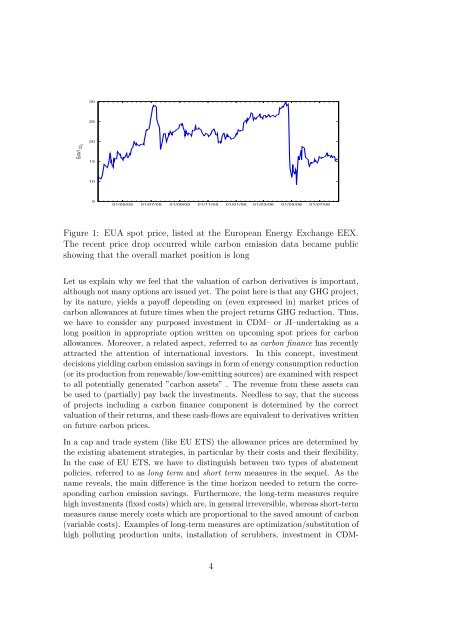A quantitative approach to carbon price risk modeling - CiteSeerX
A quantitative approach to carbon price risk modeling - CiteSeerX
A quantitative approach to carbon price risk modeling - CiteSeerX
You also want an ePaper? Increase the reach of your titles
YUMPU automatically turns print PDFs into web optimized ePapers that Google loves.
30<br />
25<br />
20<br />
Euro/ t CO2<br />
15<br />
10<br />
5<br />
01/05/05 01/07/05 01/09/05 01/11/05 01/01/06 01/03/06 01/05/06 01/07/06<br />
Figure 1: EUA spot <strong>price</strong>, listed at the European Energy Exchange EEX.<br />
The recent <strong>price</strong> drop occurred while <strong>carbon</strong> emission data became public<br />
showing that the overall market position is long<br />
Let us explain why we feel that the valuation of <strong>carbon</strong> derivatives is important,<br />
although not many options are issued yet. The point here is that any GHG project,<br />
by its nature, yields a payoff depending on (even expressed in) market <strong>price</strong>s of<br />
<strong>carbon</strong> allowances at future times when the project returns GHG reduction. Thus,<br />
we have <strong>to</strong> consider any purposed investment in CDM– or JI–undertaking as a<br />
long position in appropriate option written on upcoming spot <strong>price</strong>s for <strong>carbon</strong><br />
allowances. Moreover, a related aspect, referred <strong>to</strong> as <strong>carbon</strong> finance has recently<br />
attracted the attention of international inves<strong>to</strong>rs. In this concept, investment<br />
decisions yielding <strong>carbon</strong> emission savings in form of energy consumption reduction<br />
(or its production from renewable/low-emitting sources) are examined with respect<br />
<strong>to</strong> all potentially generated ”<strong>carbon</strong> assets” . The revenue from these assets can<br />
be used <strong>to</strong> (partially) pay back the investments. Needless <strong>to</strong> say, that the success<br />
of projects including a <strong>carbon</strong> finance component is determined by the correct<br />
valuation of their returns, and these cash-flows are equivalent <strong>to</strong> derivatives written<br />
on future <strong>carbon</strong> <strong>price</strong>s.<br />
In a cap and trade system (like EU ETS) the allowance <strong>price</strong>s are determined by<br />
the existing abatement strategies, in particular by their costs and their flexibility.<br />
In the case of EU ETS, we have <strong>to</strong> distinguish between two types of abatement<br />
policies, referred <strong>to</strong> as long term and short term measures in the sequel. As the<br />
name reveals, the main difference is the time horizon needed <strong>to</strong> return the corresponding<br />
<strong>carbon</strong> emission savings. Furthermore, the long-term measures require<br />
high investments (fixed costs) which are, in general irreversible, whereas short-term<br />
measures cause merely costs which are proportional <strong>to</strong> the saved amount of <strong>carbon</strong><br />
(variable costs). Examples of long-term measures are optimization/substitution of<br />
high polluting production units, installation of scrubbers, investment in CDM-<br />
4
















